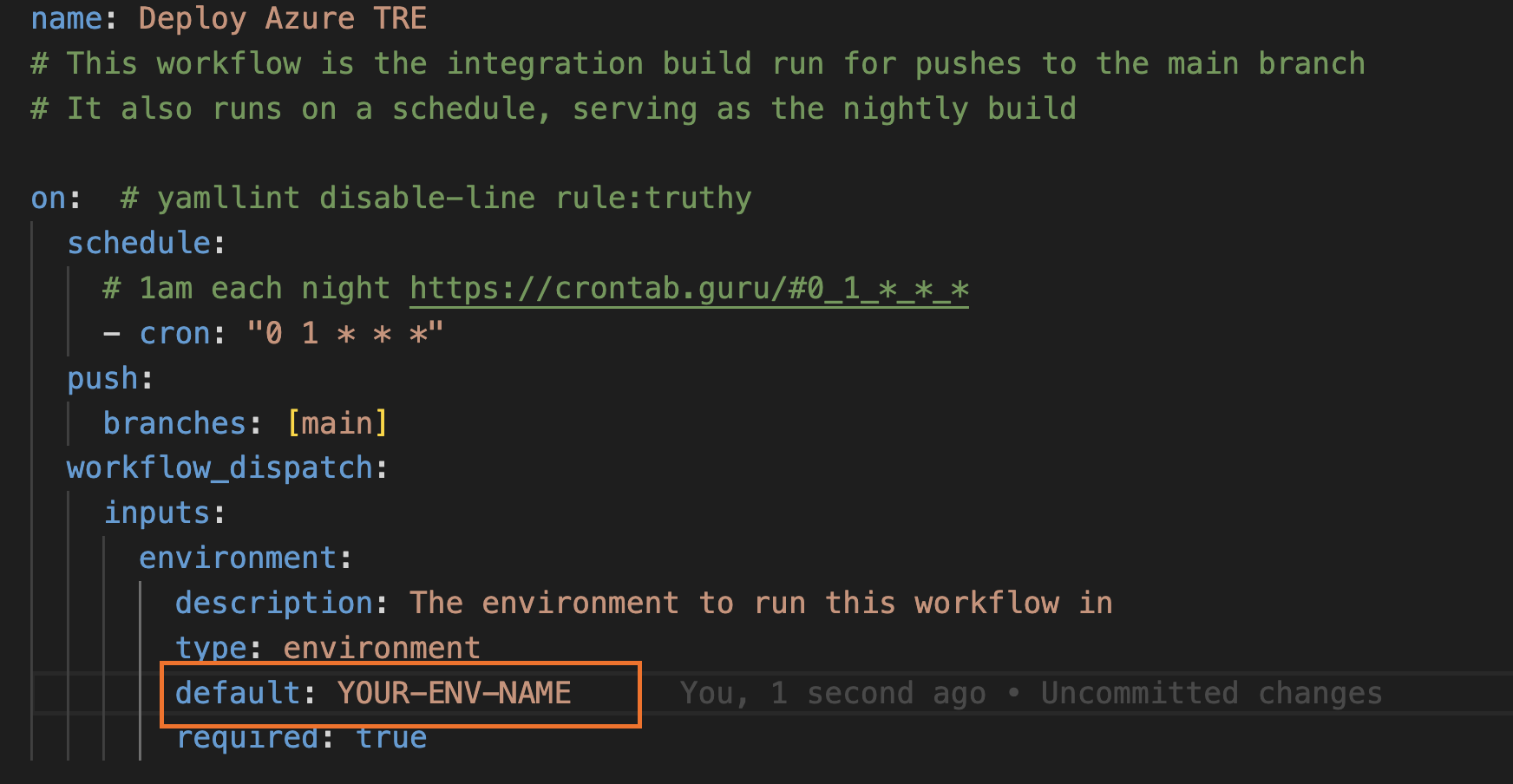Pre-deployment steps
Setup Github Environment
The workflows are using Github environment to source its environment variables. Follow this guide to define it in your github repository and provide it as an input for the workflows.
GitHub Actions workflows (CI/CD)
Deployment is done using the /.github/workflows/deploy_tre.yml workflow. This method is also used to deploy the dev/test environment for the original Azure TRE repository.
Setup instructions
Before you can run the deploy_tre.yml workflow there are some one-time configuration steps that we need to do, similar to the Pre-deployment steps for manual deployment.
- Create a service principal for the subscription so that the workflow can provision Azure resources.
- Decide on a TRE ID and the location for the Azure resources
- Create a Teams WebHook for deployment notifications
- Configure repository secrets
- Deploy the TRE using the workflow
Create a service principal for provisioning resources
-
Login to Azure
Log in to Azure using
az loginand select the Azure subscription you wish to deploy Azure TRE to:az login az account list az account set --subscription <subscription ID>See Sign in with Azure CLI for more details.
-
Create a service principal
A service principal needs to be created to authorize CI/CD workflows to provision resources for the TRE workspaces and workspace services.
Create a main service principal with "Owner" role:
az ad sp create-for-rbac --name "sp-aztre-cicd" --role Owner --scopes /subscriptions/<subscription_id> --sdk-authCaution
Save the JSON output locally - as you will need it later for setting secrets in the build
-
Create a secret in your github environment named
AZURE_CREDENTIALSand use the JSON output from the previous step as its value. Note it should look similar to this:{ "clientId": "", "clientSecret": "", "subscriptionId": "", "tenantId": "" }
Configure Core Secrets
Configure the following secrets in your github environment:
Secret name |
Description |
|---|---|
TRE_ID |
A globally unique identifier. TRE_ID can be found in the resource names of the Azure TRE instance; for example, a TRE_ID of tre-dev-42 will result in a resource group name for Azure TRE instance of rg-tre-dev-42. This must be less than 12 characters. Allowed characters: Alphanumeric, underscores, and hyphens. |
MGMT_RESOURCE_GROUP_NAME |
The name of the shared resource group for all Azure TRE core resources. |
MGMT_STORAGE_ACCOUNT_NAME |
The name of the storage account to hold the Terraform state and other deployment artifacts. E.g. mystorageaccount. |
ACR_NAME |
A globally unique name for the Azure Container Registry (ACR) that will be created to store deployment images. |
Configure Core Variables
Configure the following variables in your github environment:
Variable name |
Description |
|---|---|
LOCATION |
The Azure location (region) for all resources. E.g. westeurope |
TERRAFORM_STATE_CONTAINER_NAME |
Optional. The name of the blob container to hold the Terraform state. Default value is tfstate. |
CORE_ADDRESS_SPACE |
Optional. The address space for the Azure TRE core virtual network. Default value is 10.0.0.0/22. |
TRE_ADDRESS_SPACE |
Optional. The address space for the whole TRE environment virtual network where workspaces networks will be created (can include the core network as well). Default value is 10.0.0.0/16 |
AZURE_ENVIRONMENT |
Optional. The name of the Azure environment. Supported values are AzureCloud and AzureUSGovernment. Default value is AzureCloud. |
CORE_APP_SERVICE_PLAN_SKU |
Optional. The SKU used for AppService plan for core infrastructure. Default value is P1v2. |
WORKSPACE_APP_SERVICE_PLAN_SKU |
Optional. The SKU used for AppService plan used in E2E tests. Default value is P1v2. |
RESOURCE_PROCESSOR_NUMBER_PROCESSES_PER_INSTANCE |
Optional. The number of processes to instantiate when the Resource Processor starts. Equates to the number of parallel deployment operations possible in your TRE. Defaults to 5. |
ENABLE_SWAGGER |
Optional. Determines whether the Swagger interface for the API will be available. Default value is false. |
Configure Authentication Secrets
In a previous Setup Auth configuration step authentication configuration was added in config.yaml file. Go to this file and add those env vars to your github environment:
| Secret Name | Description |
|---|---|
AAD_TENANT_ID |
Tenant id against which auth is performed. |
APPLICATION_ADMIN_CLIENT_ID |
This client will administer AAD Applications for TRE |
APPLICATION_ADMIN_CLIENT_SECRET |
This client will administer AAD Applications for TRE |
TEST_ACCOUNT_CLIENT_ID |
This will be created by default, but can be disabled by editing /devops/scripts/create_aad_assets.sh. This is the user that will run the tests for you |
TEST_ACCOUNT_CLIENT_SECRET |
This will be created by default, but can be disabled by editing /devops/scripts/create_aad_assets.sh. This is the user that will run the tests for you |
API_CLIENT_ID |
API application (client) ID. |
API_CLIENT_SECRET |
API application client secret. |
SWAGGER_UI_CLIENT_ID |
Swagger (OpenAPI) UI application (client) ID. |
TEST_WORKSPACE_APP_ID |
Each workspace is secured behind it's own AD Application. Use the value of WORKSPACE_API_CLIENT_ID created in the /config.yaml env file |
TEST_WORKSPACE_APP_SECRET |
Each workspace is secured behind it's own AD Application. This is the secret for that application. Use the value of WORKSPACE_API_CLIENT_SECRET created in the /config.yaml env file |
Create a Teams Webhook for deployment notifications
The deploy_tre.yml workflow sends a notification to a Microsoft Teams channel when it finishes running.
Note
If you don't want to notify a channel, you can also remove the Notify dedicated teams channel steps in the workflow
-
Follow the Microsoft Docs to create a webhook for your channel
-
Configure the MS_TEAMS_WEBHOOK_URI repository secret
Secret nameDescription MS_TEAMS_WEBHOOK_URIURI for the Teams channel webhook
Info
See Environment variables for full details of the deployment related variables.
Setup Github env in workflow
In your repository you will find that the pipelines under the folder .github/workflows on top of each workflow there is the workflow inputs part where the used Github environment name is set, make sure to update it with yours, for example:

Deploy the TRE using the workflow
With all the repository secrets set, you can trigger a workflow run by pushing to develop/main of your repo, or by dispatching the workflow manually.